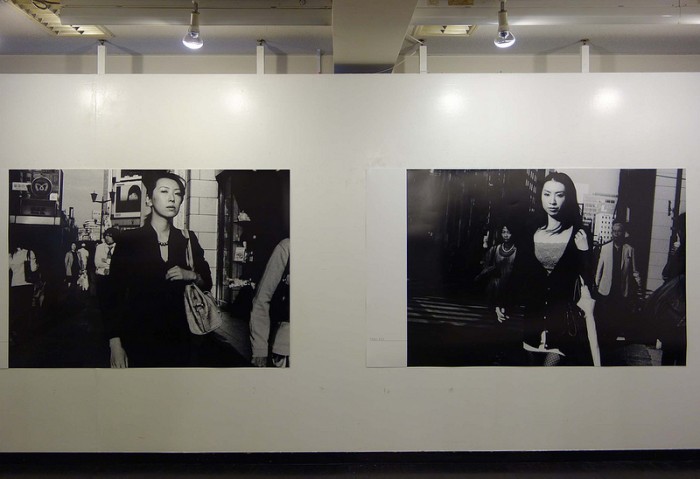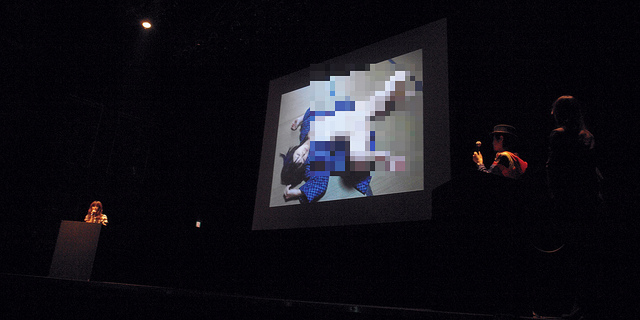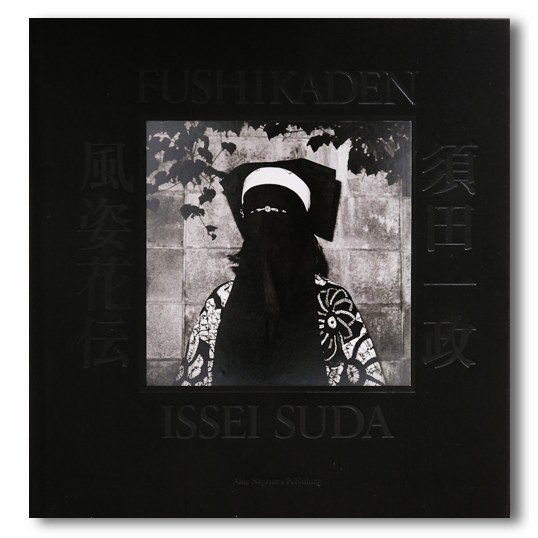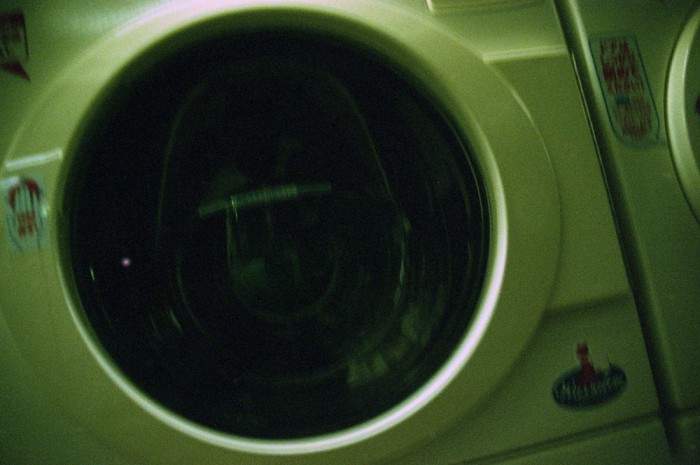
Installation view © Kobun Hayakawa
Kobun Hayakawa, “Mask Road” at Place M
In 2011, Leo Rubinfein put up a show at MOMAT, “Wounded Cities,” which had the ambitious goal of showing, through photographs, how a certain kind of fear can be literally found written on the faces of today’s city dwellers, all over the world. Rubinfein’s text made it clear that he was fully aware of how difficult this claim would be to make through photographs, and I wish that Hayakawa had taken a similar position, given that he’s trying to do a similar thing, with similar results—snapshots of people on the street, lost in thought. Hayakawa’s almost bizarre claim, though, is that this phenomenon of “mask-wearing” is particular to Tokyo. This is a flimsy proposition at best, as Rubinfein’s show alone shows. There are a few well-seen images in this series, but I’m just not convinced.

Misato Kuroda showing "Sawako" © Takumi Suidu
Misato Kuroda, “Sawako” at Jimbocho Garou
This is not the right place to trace out a history of erotic photographers in Japan, but Misato Kuroda is going to head up the list pretty soon. Sakiko Nomura comes to mind, but her images are dark and brooding, while Kuroda’s are just plain naughty. Some of her other works have been more personal, but Sawako (which has long sold out in photobook form, and is now available for 20,000 yen on Amazon) is a series showing a supple Japanese girl posing nude in a variety of locations. Kuroda has written about her early looking at porn mags, and how this experience led her to take these photos.

Issei Suda, "Fushikaden"
Issei Suda, “Fushikaden” at BLD Gallery
The book outshines the exhibit here, but only because it’s so excellent. In this work are some of Suda’s most famous shots that have been used in other books (Only Photography, Tosei-sha etc), in their “original” context. The show itself breaks up this flow, and for some reason or another didn’t do much to hold my attention. Perhaps it’s just edited in a strange way. The best part was a series of snake photos, which were hung up in the bookstore, outside of the main gallery. Still, a couple of stunners, including flashed flowers and dead goat. It’s an old lark that Japanese photography is more about books than prints (it is, but probably not in some incomprehensible way) and this was certainly true here.

© Naonori Oshima
Naonori Oshima “O/N Complex System” at Photographer’s Gallery
A good title. Digital overload kind of thing—laser prints which enhance the “digitalness.” Lots of stuff that most people would throw out, not very much that’s beautiful. This is a good thing. Portraits of people framed in the middle distance don’t really work, they’re way too normal and don’t fit the flow of the show. Kind of Kasubaba-ish, at times. Created artist book in ed. of 10, ¥25,000 – pretty smart. Prints edition of 7 for ¥12,000 – also good. Says he’s not trying to have meaning in one image, I can agree with that. Kind of Kitajima influence (uncommon places style) at times. He’s the youngest member of pg, worth tracking.
Wataru Yamamoto, “Wataru Album” at Chateau 2F
This was part of a group show, with some other photographers, but I can’t even bring myself to write anything about the other people. Wataru has been going to the same photo studio in his hometown since he was a child, and he displayed those albums in this exhibit. It’s fun to see his evolution from a table-tennis playing elementary school kid to a “bad boy” junior high schooler, to a nature-loving college student. The last album shows him posing together with the photographer, who’s still going strong after all these years. Wataru is giving me some real hope about photography in Japan; he is full of ideas and knows how to execute them without trying to do too much.
Asako Narahashi, “in the plural” at Zeit Foto Salon
Known for her “half asleep” series, of course, and there are many of these photos here, including two more of the hit combination of Mt. Fuji + a sweet wave. It may be cliched at this point, but I have to admit it still looks great, and at least the prints at this show weren’t a mess like the ones I saw in 2010. When she looks away from the ocean, there are some great results: a photograph of a field of archery targets nestled in a distant field (seen from above) is an excellent, effortless way to meditate on photographing. A sequence of 2 photos going up a lift, looking back at a snow-covered town, also works well, or at least shows something of Narahashi’s vision, which can be somewhat radical in the way she frames and edits–when she’s out of the water, her images are not actually very beautiful at all, and I think (to her credit) that’s intentional. It’s as if with the water images, she stumbled on a way to make things beautiful, but the aesthetic power of those images is distracting you from what she’s actually trying to do with her work. I might be wrong, and I’m still not exactly sure what she *is* trying to do. There was a little book of notes for sale, but I didn’t buy it because I wasn’t trying to practice reading Japanese then (I am now). Next time.
Scheltens & Abbenes, “I put this here” at LimArt
If you include the activities of its sister shop, POST, LimArt is establishing itself as the best place in Tokyo to view contemporary European photography. A+S’s work is certainly very conceptual, and it was a little bit difficult to grasp, but still, it’s a change of pace from what’s normally exhibited here. The person at the desk said people responded to the show by saying it’s “interesting because it has a different approach”; I’m hoping people will have learned something from it, rather than taking a glance, saying, “huh,” and moving on. Let’s wait five years and see.
Chihiro Ichinose, “Kitsilano” at Nikon Ginza
Kind of like Kawauchi—somewhat magical photos of a trip to Holland—but with a more experimental darkroom style: bands of color (or splotches, sometimes covering the entire image) streaking across the paper. It’s a surprising way of presenting such otherwise tame material, though Ichinose’s statement works against this good work: she reflects explicitly on her own technique, but without offering any more insight than, “I was thinking about photos and, I dunno, I thought I’d try something weird.” Better to leave that unsaid! It seems like she’s close to hitting on something, but also like (as said in her statement) she’s just beginning to question the nature of photographs. I’m curious to see what answers she finds.
Arita Taiji, “First Born” at 916 Gallery
An extremely formal show, to the level of Ueda Shoji, which is not a good thing. Everything is set up. A couple of nice images but no impact–maybe I need to have kids? Prints, by Ueda Y, are nice, but still. Maybe the work was better at the time? It feels boring now. The large frames for otherwise small prints seemed like a half-hearted attempt to try to fill this massive space, but it was a mismatch—it felt like miles between one print and the next, which doesn’t work for these photos. Just not sure why it should be presented now.
Syabi “Young photographers” jam
Masumi Kura: Loose way of ordering street snaps, maybe good in 20-30 years.
Keiko Sasaoka: Careful landscapes, really pretty, too pretty maybe. I wonder of Fishing (like Narahashi’s archery) could be thought of as an image of photographing. Not sure if Sasaoka has thought of this though.
Chiro Otsuka: Very conceptual, but so inward-looking. Re-tracing her own memories of childhood, going back to places she visited as a child and re-photographing herself there, then digitally re-inserting herself into the image. The work did not not offer much more than the possibility to say “oh cool” and move on.
Tomoko Kikuchi: Photographs of the trans scene in China. Extremely powerful subject matter, which she did well to capture. No innovations photographically, but the work is still important as a historical document; it makes sense to us today in the way that Kura’s photographs do not, even though they are technically better.
Lewis Baltz/Toshio Shibata at Shadai Gallery
Shibata’s stuff is old (late 80s/early 90s), just shows him doing his thing. This was my first time to see Lewis Baltz prints in real life, they’re really good. I haven’t seen Marten Lange prints but I hope they look like this. Very bright whites and just a few blacks coming through. Desert detritus, around Reno. It’s good. Old world photography, really classical, photo as window.



